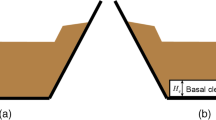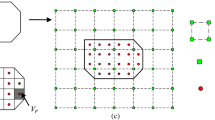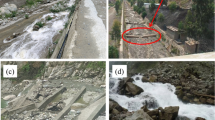Abstract
Baffles and check-dam systems are often used as granular flow (rock avalanches, debris flows, etc.) control structures in regions prone to dangerous geological hazards leading to massive landslides. This paper explores the use of numerical modelling to simulate large volume granular flow and the effect of the presence of baffles and check dam systems on granular flow. In particular, the paper offers a solution based on the smoothed particle hydrodynamics numerical method, combined with a modified Bingham model with Mohr–Coulomb yield stress for granular flows. This method is parallelised at a large scale to perform high-resolution simulations of sand flowing down an inclined flume, obstructed by rigid control structures. We found that to maximise the flow deceleration ability of baffle arrays, the design of baffle height ought to reach a minimum critical value, which can be quantified from the flow depth without baffles (e.g. 2.7 times for frictional flows with friction angle of 27.5°). Also, the check-dam system was found to minimise run-out distances more effectively but experiences substantially higher forces compared to baffles. Finally, flow-control structures that resulted in lower run-out distances were associated with lower total energy dissipation, but faster kinetic energy dissipation in the granular flows; as well as lower downstream peak flow rates.



















Similar content being viewed by others
References
Iverson RM, Schilling SP, Vallance JW (1998) Objective delineation of lahar-inundation hazard zones. GSA Bulletin 110(8):972–984
Jakob M, Weatherly H (2003) A hydroclimatic threshold for landslide initiation on the North Shore Mountains of Vancouver British Columbia. Geomorphology 54(3):137–156
Rosser B et al (2017) New Zealand’s National Landslide Database. Landslides 14(6):1949–1959
Choi C et al (2015) Computational investigation of baffle configuration on impedance of channelized debris flow. Can Geotech J 52(2):182–197
Mizuyama T (2008) Structural countermeasures for debris flow disasters. Int J Erosion Control Eng 1(2):38–43
Wendeler C et al (2008) Hazard prevention using flexible multi-level debris flow barriers. Proc of Int Symp Interpraevent 1:547–554
Choi KY, Cheung RWM (2013) Landslide disaster prevention and mitigation through works in Hong Kong. J Rock Mech Geotech Eng 5(5):354–365
Cosenza E et al (2006) Concrete structures for mitigation of debris-flow hazard in the Montoro Inferiore Area, Southern Italy
Ng CWW et al (2018) Dry granular flow interaction with dual-barrier systems. Géotechnique 68(5):386–399
Hákonardóttir KM et al (2003) A laboratory study of the retarding effects of braking mounds on snow avalanches. J Glaciol 49(165):191–200
Jóhannesson T et al (2008) The design of avalanche protection dams. Recent practical and theoretical developments
Lau C, Chan E, Kwan J (2012) Natural terrain hazard mitigation measures
Kwan J (2012) Supplementary technical guidance on design of rigid debris-resisting barriers. Geotechnical Engineering Office, HKSAR. GEO Report, p 270
Kwan J, Koo R, Lam C (2018) Review on the design of rigid debris-resisting barriers
Major JJ (1997) Depositional processes in large-scale debris-flow experiments. J Geol 105(3):345–366
Naaim M et al (2010) Return period calculation and passive structure design at the Taconnaz avalanche path France. Ann Glaciol 51(54):89–97
Sulsky D, Chen Z, Schreyer HL (1994) A particle method for history-dependent materials. Comput Methods Appl Mech Eng 118(1–2):179–196
Zhang X et al (2013) Particle finite element analysis of large deformation and granular flow problems. Comput Geotech 54:133–142
Soga K et al (2016) Trends in large-deformation analysis of landslide mass movements with particular emphasis on the material point method. Géotechnique 66(3):248–273
Lucy LB (1977) A numerical approach to the testing of the fission hypothesis. Astronom J 82:1013–1024
Gingold RA, Monaghan JJ (1977) Smoothed particle hydrodynamics: theory and application to non-spherical stars. Mon Not R Astron Soc 181(3):375–389
Cundall PA, Strack OD (1979) A discrete numerical model for granular assemblies. Geotechnique 29(1):47–65
Monaghan JJ (1994) Simulating free surface flows with SPH. J Comput Phys 110(2):399–406
Libersky LD, Petschek AG (1991) Smooth particle hydrodynamics with strength of materials. Springer, Berlin
Bui HH et al (2008) Lagrangian meshfree particles method (SPH) for large deformation and failure flows of geomaterial using elastic–plastic soil constitutive model. Int J Numer Anal Meth Geomech 32(12):1537–1570
Pastor M et al (2009) A depth-integrated, coupled SPH model for flow-like landslides and related phenomena. Int J Numer Anal Meth Geomech 33(2):143–172
Bui HH et al (2011) Slope stability analysis and discontinuous slope failure simulation by elasto-plastic smoothed particle hydrodynamics (SPH). Géotechnique 61(7):565–574
Nonoyama H et al (2015) Slope stability analysis using smoothed particle hydrodynamics (SPH) method. Soils Found 55(2):458–470
Bui HH, Nguyen GD (2017) A coupled fluid-solid SPH approach to modelling flow through deformable porous media. Int J Solids Struct 125:244–264
Bui HH, Sako K, Fukagawa R (2007) Numerical simulation of soil–water interaction using smoothed particle hydrodynamics (SPH) method. J Terrramech 44(5):339–346
Tran HT et al (2019) Modelling 3D desiccation cracking in clayey soils using a size-dependent SPH computational approach. Comput Geotech 116:103209
Wang Y et al (2020) Simulation of mixed‐mode fracture using SPH particles with an embedded fracture process zone. Int J Numer Anal Methods Geomech
Wang Y et al (2019) A new SPH-based continuum framework with an embedded fracture process zone for modelling rock fracture. Int J Solids Struct 159:40–57
Chen W, Qiu T (2012) Numerical simulations for large deformation of granular materials using smoothed particle hydrodynamics method. Int J Geomech 12(2):127–135
Favero A, Borja R (2018) Continuum hydrodynamics of dry granular flows employing multiplicative elastoplasticity. Acta Geotech
Ghaïtanellis A et al (2018) A SPH elastic-viscoplastic model for granular flows and bed-load transport. Adv Water Resour 111:156–173
He X et al (2018) Study of the interaction between dry granular flows and rigid barriers with an SPH model. Int J Numer Anal Meth Geomech 42(11):1217–1234
Longo A et al (2019) A depth average SPH model including μ (I) rheology and crushing for rock avalanches. Int J Numer Anal Meth Geomech 43(5):833–857
Neto AHF, Borja RI (2018) Continuum hydrodynamics of dry granular flows employing multiplicative elastoplasticity. Acta Geotech 13(5):1027–1040
Nguyen CT et al (2017) A new SPH-based approach to simulation of granular flows using viscous damping and stress regularisation. Landslides 14(1):69–81
Manzanal D et al (2016) Application of a new rheological model to rock avalanches: an SPH approach. Rock Mech Rock Eng 49(6):2353–2372
Nguyen NH, Bui HH, Nguyen GD (2020) Effects of material properties on the mobility of granular flow. Granular Matter 22:59
Bui H, Nguyen GD (2020) Numerical predictions of post-flow behaviour of granular materials using an improved SPH model. In: CIGOS 2019, innovation for sustainable infrastructure. Springer, Berlin, p 895–900
Bui HH et al (2014) A novel computational approach for large deformation and post-failure analyses of segmental retaining wall systems. Int J Numer Anal Meth Geomech 38(13):1321–1340
Bui HH et al (2008) SPH-based numerical simulations for large deformation of geomaterial considering soil-structure interaction. In: The 12th international conference of international association for computer methods and advances in geomechanics (IACMAG). 2008.
Faug T (2015) Macroscopic force experienced by extended objects in granular flows over a very broad Froude-number range. Europ Phys J E 38(5):1–10
Peng C et al (2019) LOQUAT: an open-source GPU-accelerated SPH solver for geotechnical modeling. Acta Geotech 14(5):1269–1287
Yang E et al (2020) A scalable parallel computing SPH framework for predictions of geophysical granular flows. Comput Geotech 121:103474
Valdez-Balderas D et al (2013) Towards accelerating smoothed particle hydrodynamics simulations for free-surface flows on multi-GPU clusters. J Parallel Distrib Comput 73(11):1483–1493
Oger G et al (2016) On distributed memory MPI-based parallelization of SPH codes in massive HPC context. Comput Phys Commun 200:1–14
Ng CWW et al (2015) Physical modeling of baffles influence on landslide debris mobility. Landslides 12(1):1–18
Naaim M, Faug T, Naaim-Bouvet F (2003) Dry granular flow modelling including erosion and deposition. Surv Geophys 24(5–6):569–585
Kattel P et al (2018) Interaction of two-phase debris flow with obstacles. Eng Geol 242:197–217
Dehnen W, Aly H (2012) Improving convergence in smoothed particle hydrodynamics simulations without pairing instability. Mon Not R Astron Soc 425(2):1068–1082
Antuono M et al (2010) Free-surface flows solved by means of SPH schemes with numerical diffusive terms. Comput Phys Commun 181(3):532–549
Oger G et al (2007) An improved SPH method: Towards higher order convergence. J Comput Phys 225(2):1472–1492
Blanc T, Pastor M (2013) A stabilized Smoothed Particle Hydrodynamics, Taylor-Galerkin algorithm for soil dynamics problems. Int J Numer Anal Meth Geomech 37(1):1–30
Moriguchi S et al (2009) Estimating the impact force generated by granular flow on a rigid obstruction. Acta Geotech 4(1):57–71
Moriguchi S et al (2005) Numerical simulation of flow failure of geomaterials based on fluid dynamics. Soils Found 45(2):155–165
Uzuoka R (2000) Analytical study on the mechanical behavior and prediction of soil liquefaction and flow. Ph. D. Dissertation, Gifu University
Lagrée P-Y, Staron L, Popinet S (2011) The granular column collapse as a continuum: validity of a two-dimensional Navier–Stokes model with a μ (I)-rheology. J Fluid Mech 686:378–408
Papanastasiou TC (1987) Flows of materials with yield. J Rheol 31(5):385–404
Adami S, Hu XY, Adams NA (2012) A generalized wall boundary condition for smoothed particle hydrodynamics. J Comput Phys 231(21):7057–7075
Morris JP, Fox PJ, Zhu Y (1997) Modeling low reynolds number incompressible flows using SPH. J Comput Phys 136(1):214–226
Marrone S et al (2011) Computer methods in applied mechanics and engineering. Comput Method Appl Mech Eng 200:1526–1542
Nomeritae N et al (2016) Explicit incompressible SPH algorithm for free-surface flow modelling: a comparison with weakly compressible schemes. Adv Water Resour 97:156–167
Liu M, Shao J, Chang J (2012) On the treatment of solid boundary in smoothed particle hydrodynamics. Sci China Technol Sci 55(1):244–254
Liu GR, Liu MB (2003) Smoothed Particle Hydrodynamics: A Meshfree Particle Method
Cui X, Gray J (2013) Gravity-driven granular free-surface flow around a circular cylinder. J Fluid Mech 720:314–337
Monaghan JJ (1992) Smoothed particle hydrodynamics. Ann Rev Astron Astrophys 30(1):543–574
Monaghan JJ (2000) SPH without a tensile instability. J Comput Phys 159(2):290–311
Lind SJ et al (2012) Incompressible smoothed particle hydrodynamics for free-surface flows: a generalised diffusion-based algorithm for stability and validations for impulsive flows and propagating waves. J Comput Phys 231(4):1499–1523
Sun PN et al (2017) The δplus-SPH model: Simple procedures for a further improvement of the SPH scheme. Comput Methods Appl Mech Eng 315:25–49
Khayyer A, Gotoh H, Shimizu Y (2017) Comparative study on accuracy and conservation properties of two particle regularization schemes and proposal of an optimized particle shifting scheme in ISPH context. J Comput Phys 332:236–256
Xu R, Stansby P, Laurence D (2009) Accuracy and stability in incompressible SPH (ISPH) based on the projection method and a new approach. J Comput Phys 228(18):6703–6725
Colagrossi A et al (2012) Particle packing algorithm for SPH schemes. Comput Phys Commun 183(8):1641–1653
Terzaghi K (1943) Arching in ideal soils. Theor Soil Mech, pp 66–76
Staron L, Lagrée P-Y, Popinet S (2014) Continuum simulation of the discharge of the granular silo: a validation test for the μ(I) visco-Plastic flow law. Europ Phys J E Soft Matter 37:9961
Choi CE et al (2014) Flume investigation of landslide debris–resisting baffles. Can Geotech J 51(5):540–553
Marrone S et al (2010) Fast free-surface detection and level-set function definition in SPH solvers. J Comput Phys 229(10):3652–3663
Chambon G et al (2011) Numerical simulations of granular free-surface flows using smoothed particle hydrodynamics. J Nonnewton Fluid Mech 166(12–13):698–712
Kwan J (2012) Supplementary technical guidance on design of rigid debris-resisting barriers
Koo R et al (2017) Velocity attenuation of debris flows and a new momentum-based load model for rigid barriers. Landslides 14(2):617–629
Van Dine D (1996) Debris flow control structures for forest engineering. Research Branch BC Min For, Victoria, BC, Working Paper, vol 8
Iverson RM (1997) The physics of debris flows. Rev Geophys 35(3):245–296
Acknowledgements
Funding support from the Australian Research Council via Projects DP170103793, DP190102779, and FT200100884, and from NSERC Canada via Project RGPIN-2019–04,155, from the National Natural Science Foundation of China (5,170,091,039), as well as the Research Grants Council of Hong Kong (16,212,618; 16,209,717; 16,210,219; T22-603/15 N; AoE/E-603/18), is gratefully acknowledged. This research was undertaken with the assistance of resources and services from the National Computational Infrastructure (NCI), which is supported by the Australian Government.
Author information
Authors and Affiliations
Corresponding author
Additional information
Publisher's Note
Springer Nature remains neutral with regard to jurisdictional claims in published maps and institutional affiliations.
Rights and permissions
About this article
Cite this article
Yang, E., Bui, H.H., Nguyen, G.D. et al. Numerical investigation of the mechanism of granular flow impact on rigid control structures. Acta Geotech. 16, 2505–2527 (2021). https://doi.org/10.1007/s11440-021-01162-4
Received:
Accepted:
Published:
Issue Date:
DOI: https://doi.org/10.1007/s11440-021-01162-4




